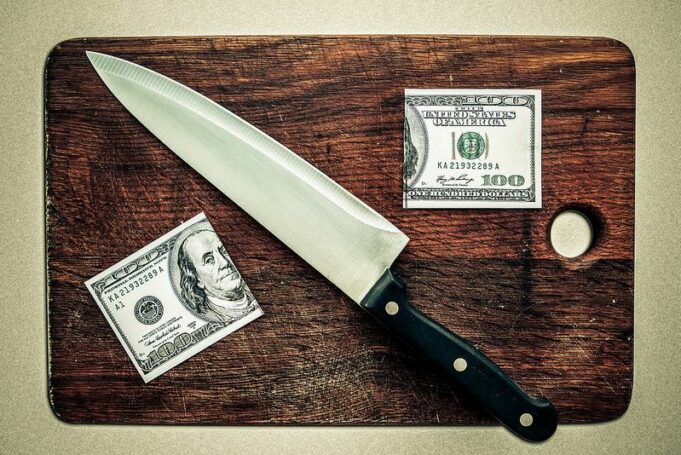When I first decided to try the paleo diet, it was as a last resort to find relief from the every-day pains and stress of living with multiple chronic illnesses. After seeing how eating primarily an ancestral diet has healed myself and my family in more ways than we ever could have imagined, I became passionate about finding ways to make sure it was made accessible to as many people as possible. The darker side of the natural health community, in general, is the elitism/privilege of some that are often used to shame those who may not have access to or be able to afford “the best of the best.” I know what it’s like to get caught up in an all-or-nothing mentality, but the reality of progress is better than the illusion of perfection. Here are twelve things that have helped me to save money while eating this way:
1.) Minimize Food Waste
one of the biggest wastes of grocery money for me personally has been food rotting in my refrigerator. As someone who struggles with complex PTSD and panic disorder, sometimes my mental health is so poor that I don’t have any energy left over to cook. That leaves me with wasted money, wasted food, and a terrible sense of guilt for wasting both of those resources. Here are the things that have helped me minimize food waste:
•Buy frozen produce- often times frozen produce is cheaper than fresh, and unlike fresh produce- which is often picked before its fully ripe, frozen produce is frozen at peak freshness and retains a lot more nutrients that way. Staples in my freezer are frozen broccoli, green beans, and frozen berries for my smoothies.
•Every few days, I’ll do a “leftovers sweep” and go through my entire fridge and make a list of leftovers and random ingredients I have on hand. Three of my favorite dishes to use up leftovers are frittatas, a stir-fry, or crockpot minestrone soup.
•Two-three times a week when I have some extra time and energy, I will batch cook all the meat I’ll be needing for the next few days- it’s so much easier on bad mental health or even just busy days to reheat meat than it is to take it from raw to cooked.
•Keep track of what’s in your fridge, freezer, and pantry/cabinets and meal plan at least a few days in advance.
2.) Don’t Spend So Much Money On Expensive Substitutions-
When I first started eating this way years ago, I was always falling into the trap of trying to “replace” my unhealthy favorites. I would spend a lot of money on alternative flours to make grain-free bread, paleo cupcakes, you name it. Now it’s easier to find pre-made substitutes in stores- but they are pricey. For example, a package of 5 coconut flour wraps is almost $10 at my local grocery store. I save a lot of money by skipping the wrap altogether, rather than choosing a healthier version.
Sticking to the basics- healthy fats, meat, veggies, and a little fruit has helped me to stay within my budget.
3.) Don’t Stress Out About Organics
I learned recently that a lot of people don’t realize that organic produce is often still sprayed with pesticides- only ones deemed safer than conventional. Eating conventional produce and meat is infinitely better for your health than eating over-processed Frankenfoods. Eating conventional produce and meat is perfectly fine if that’s what you can afford. If you can afford to eat organic sometimes, prioritize things like apples and berries that don’t have an outer layer to protect them. I never buy things like avocados, bananas, and onions organic. Although, the best value for your money is to prioritize grass-fed, naturally raised meat- if and when you are able to. If you can not afford to do so, don’t stress it- you’re doing just fine.
4.) Pass On Meal Delivery Services
Unless you need them due to an illness or disability, healthy meal delivery services are extremely expensive. They are often advertised as being a good value, but it will cost you a fraction of the price to make the same dishes at home.
5.) Consider Shopping at Online Stores Like Thrive Market For Your Pantry Staples
Thrive Market is where I buy 90% of my non-perishables like coconut oil, extra virgin olive oil, and clean protein bars. They do sell meat now as well, but I can often find better deals on that in my local grocery stores. I’ve been able to find many items for 50-80% cheaper than I’ve seen them anywhere else there, and they have a lot of great sales. It has been described as what would happen if Costco and Whole Foods had a baby. I saved quadruple the yearly membership fee of $59.95 in my first order online. If you are interested in signing up, you can use my link http://thrv.me/qSCRR9 for an additional 25% off your first order.
6.) Invest In A Deep Freezer
You can often find pre-owned deep freezers for a good price online, and sometimes stores like Lowe’s will sell dented or otherwise superficially imperfect ones at a steep discount. Having a deep freezer will allow you to stock up on frozen produce and meat when there are sales. You can save a ton of money by buying meat in bulk from farmers- for example, you can buy halves or quarters of a cow, lamb, pork, or bison. You can also buy whole chickens on sale which will cost less than buying chicken breasts or thighs separately.
7.) Make Eggs A Staple Protein Source
I try to eat eggs at least once a day. Whether you buy the least expensive eggs you can find or the free-range ones, eggs still come out to a great bang for your buck. They are also one of the most versatile foods- you can boil them, scramble them, fry them, and so much more- my personal favorite is frittatas because you can add in a lot of vegetables.
8.) Render Animal Fat
This is especially healthy if it’s from a grass-fed, free-range animal. When I cook fattier cuts of meat or higher fat ratio ground beef, I will then roast carrots or another vegetable in the pan immediately after. I also will save the fat from making bacon and cook my eggs it vegetables in it. You can buy pre-made tallow or lard from naturally raised animals, but it is often pricey. I save money by using the fat that I already have on hand from my cooking.
9.) Save The Bones
Whenever you eat meat with the bone in, save the bone in your freezer and when you have enough, make home-made bone broth. You can google a recipe that’s compatible with the type of cookware you prefer, such as a crockpot or stockpot. Bone broth is ultra-rich in collagen and has been instrumental in my healing, and it helps save money and minimize waste to make your own out of bones you might usually just throw away. You can then use this stock to make soup or to cook your food in.
10.) Eat Organ Meats
Although they may not sound appetizing to anyone not used to them, organ meats like liver, kidneys, heart or brain are not only very cheap but are nutritional powerhouses. Many traditional cultures preferred them over muscle meat for their greater nutritional value. Eating beef liver, in particular, has helped my body to heal from chronic illnesses that I struggled with for many years. My favorite way to cook liver is by chopping it into small pieces and mixing into a home-made meatloaf with ground beef and chopped bacon or to sauté it with onions.
11.) Buy Healthy Fats In Bulk Online
I’ve been able to save a lot of money on healthy fats by doing so. ThriveMarket.com and Vitacost.com are great places to get huge jars of coconut oil for a good price. When Kasandrinos.com has a sale, I buy their olive oil in the 3 liters can. You can also find many nuts and seeds in bulk and freeze them in single-serving bags to help prolong their freshness.
12.) Buy Tougher Cuts of Meat
Tough cuts of meat are always cheaper, sometimes significantly so. To make them taste great, I will slow cook them in my crockpot, usually in some broth. Marinating them beforehand with a marinade containing an acid like lemon juice or vinegar also helps with this.
I’ve been able to save a lot of money by using these tips and by cooking at home instead of going out to eat. Above all else, give yourself credit for aiming to do the best you can with what you have and avoid comparing yourself to others. You are doing just fine.





